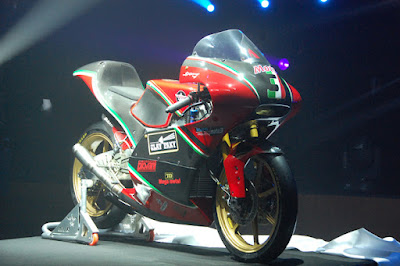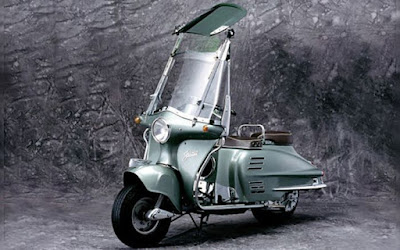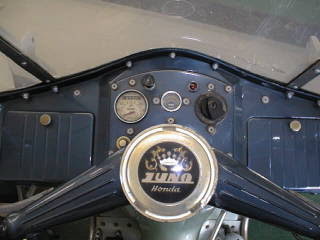Weird FROGS - Did you know that in the past there was a Yamaha poster that contained a picture of a large Frog in the middle of the road being illuminated by a light. I don't know what this poster means, what is certain is that this Japanese motorcycle manufacturer is not selling Frogs.
 |
| Do any of you know what this Yamaha scooter model is called? (Picture from: RiderTua) |
So what does Yamaha have to do with the Frog? Of course this piqued our curiosity to find out if Yamaha had a close relationship with the Frog? Indeed, not many people know that in the past this Japanese motorcycle manufacturer had a two-wheeled vehicle that wore the Frog name.
 |
| A funny, weird Yamaha poster that contained a picture of a large Frog in the middle of the road being illuminated by a vehicle headlight. (Picture from: RiderTua) |
And what we found at least, there were two Yamaha models of two-wheeled vehicles that carried the name Frog, as described below;
1. Yamaha Frog Electric Scooter Concept
This scooter not only carries the name Frog (as you can see on the sides), but also has a unique shape which at first glance is indeed very similar to the amphibious creatures. As you can see the front fascia is different from the majority of scooters currently on the market. There are two headlamps that stick out like a frog's eyes, and a fender that is attached to the body.
 |
| This possibility is one of the electric powered scooter concepts made by Yamaha back in the 1991. (Picture from: RiderTua) |
The shape of the fender is different from the majority of current scooters which are separate from the body. At a glance, its shape reminds the public three-wheeled vehicles of the past, namely the Daihatsu Midget MP4 or in Indonesian called as Bemo. Turning to the back of the shape is also no less unique. The rear body piece is slightly ''bloated'', almost like one on the Vespa automatic scooter, coupled with the single-seat similar to the one on the Vespa 948. The rear stop and turn signal lights are also round like the front.
 |
| Yamaha had released Vinoora scooter for the Taiwan market in 2020, which has a similar unique-looking of the 1991 Yamaha Frog scooter. (Picture from: SerambiNews) |
Unfortunately the drivetrain details which are not known, the information is also very scanty. This possibility is one of the electric powered scooter concepts made by Yamaha back in the 1991. And this Japanese motorcycle manufacturer launched the production of a similar scooter for the Taiwan market was named the Yamaha Vinoora in the 2020.
2. Yamaha Frog FZ750 Concept
The following one is also named Frog or the full Yamaha Frog FZ750 concept bike made by Frog Design in 1985 on the basis of the Yamaha FZ750. The company that designed this motorcycle is actually a company founded by Hartmut Esslinger in 1969 and is known as the designer for Apple computer casings in the 1980s.
 |
| The Yamaha Frog FZ750 motorbike concept made by Frog Design in 1985 on the basis of the Yamaha FZ750. (Picture from: RiderTua) |
And the beginning of the birth of the Yamaha Frog FZ750 itself was because at that time Frog Design took part in a Yamaha motorcycle design competition held in collaboration with a German motorcycle magazine Motorrad. The goal is to get a safer and more beautiful motor design. Hartmut Esslinger said that apart from creating a futuristic design he also integrated safety features found by the University of Bochum, Germany. These features affect the design of the body and fuel tank of the Frog FZ750.
 |
| Even though the Yamaha Frog FZ750 is considered the most innovative invention of the time, Yamaha is reluctant to mass-produce this motorbike because it is considered impractical. (Picture from: RiderTua) |
 On the other hand, Esslinger also innovated in the lighting sector by adding dual main lights to maximize lighting. He also designed the rim design from carbon fiber. Yamaha Frog FZ750 was the most innovative invention at that time. Now the motorbike is at the Yamaha headquarters in Hammamatsu, Japan. Even though it is considered the most innovative invention, Yamaha is reluctant to mass-produce this motorbike because it is considered impractical.
On the other hand, Esslinger also innovated in the lighting sector by adding dual main lights to maximize lighting. He also designed the rim design from carbon fiber. Yamaha Frog FZ750 was the most innovative invention at that time. Now the motorbike is at the Yamaha headquarters in Hammamatsu, Japan. Even though it is considered the most innovative invention, Yamaha is reluctant to mass-produce this motorbike because it is considered impractical.Kept spur your adrenaline on the power of two-wheeled monster and stay alive with the true safety
riding. May God will forgive Your sins and so does the cops...... *** [EKA | FROM VARIOUS SOURCES | RIDEAPART ]
Note: This blog can be accessed via your smart phone.
















































